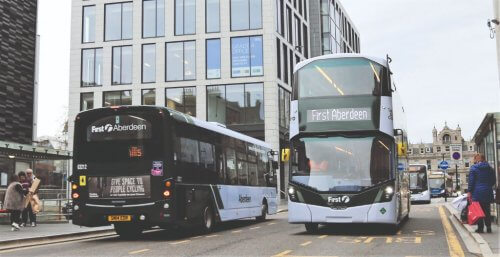
Latest figures from the 2020 edition of the Scottish Transport Statistics report showed a slight decline in the number of bus journeys, against a small overall population increase
The report shows that in 2019-20, 502 million public transport journeys were made by bus, rail, air and ferry in Scotland, which represents a decrease on the 517 million public transport journeys in 2018-19. Of these, 73% were by bus, 19% by rail, 6% by air and 2% by ferry. Two thirds of commuters said that they travelled to work by car or van in 2019, 12% walked, 10% took the bus, 5% used the train and 3% cycled.
Over the last five years, there have been increases in car traffic, and in air, rail and ferry passenger numbers. Conversely, the number of bus passengers has decreased over the same time period, whilst Scotland’s population increased by 2%.
In 2019-20 there were 366 million bus passenger journeys, a decrease of 3.2% on the previous year, or 11.6% over five years from 414 million in 2014-15, and representing a fall of 25% from a peak in 2007-08. Two fifths of all bus journeys in 2019-20 were made under the National Concessionary Travel scheme. The longer-term trend shows that the number of bus journeys almost halved between 1960 and 1975, and has roughly halved again since then.
Although vehicle kilometres have risen by 1% over the last year, the distance covered fell in eight of the last 12 years. The number of buses in operators’ fleets has increased by 3% since 2014-15 and there has been a 5% increase in the number of staff employed in the industry over the same period, the report found.
In line with Great Britain as a whole, Scotland has seen passenger journeys fall by 12% over the past five years. In Great Britain, vehicle kilometres fell by 10%, compared to no change for Scotland in the period. The picture of Scottish bus use also contrasts with rail travel in Scotland, which equates to only a quarter of the passenger journeys made by bus but has seen steady increases in passenger numbers over the past few years.
Bus travel in the South West, Strathclyde and South East (corresponding to the Regional Transport Partnership areas of SPT, SWestrans (Dumfries and Galloway) and SEStran) accounts for 84% of bus journeys in Scotland, and predictably bus use remains higher in urban areas and lower in rural areas.
Bus operators in Scotland received £694 million in revenue in 2018-19, an increase of 1% on the previous year and a 5% increase over the last five years. Adjusting for the effects of inflation, total passenger revenue was 4% less than five years ago, with almost half (£314 million, 45%) of operator revenue coming from local or central government, either through concessionary travel reimbursement, Bus Service Operators Grant (BSOG) or supported services.
Passenger revenue accounted for the remainder of operators’ revenue – additional non-revenue support such as the Scottish Green Bus Fund and the Bus Investment fund is excluded from these figures. In real terms, the report showed funding from local and national government to be 4% lower than five years ago and overall passenger revenue is 3% lower over the same period.
Over the last five years, passenger revenue has not increased due to a 10% decrease in passenger numbers, although fares in the same period have increased by 9% above general inflation – the increase for Great Britain as a whole was 4%.

